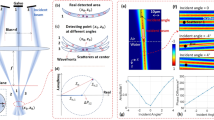Abstract
The axial resolution of optical coherence tomography (OCT) is closely related to the light source spectrum width. Unfortunately, most basic sources providing the required power for decent OCT image have narrow spectra, which generate a resolution loss. Assuming the OCT system is linear shift-invariant, we can consider the system output as the convolution of the theoretical signal with a system impulse response due to this spectrum narrowness. It becomes then possible to enhance this resolution through iterative deconvolution methods (IDM). However those methods have a significant drawback, as they usually significantly enhance speckle, which is another consequence of the source spectrum narrowness. To compensate this, we rely on preliminary speckle filtering, and especially the adaptative ones, which allow tackling the speckle without blurring the image. We first studied enhancement proposed by most popular IDMs on OCT images, and then the effect of preliminary adaptive speckle filtering (ASF) by different common adaptive methods. Then, among those methods, we combined Frost filter and Richardson-Lucy deconvolution in the appropriated way; this way we both enhanced resolution by 2 and reduced speckle (raising CNR from 0.7 to 1.3)
Similar content being viewed by others
References
Crilly, P.B. IEEE Trans. Instrum. meas.40, 1991.
Frost, V.S., J.A. Stiles, K.S. Shanmugan and J.C. Holtzman. IEEE Trans. pattern anal. machine intell. PAMI-4, 1982.
Jansson, P.A. Deconvolution of Images and Spectra, 2nd edn. Academic Press, Inc., 1997.
Kuan, D.T., A.A. Sawchuck, T.C. Strand and P. Chavel. IEEE Trans. Acoustics, Speech Signal Processing, ASSP-35, 1987.
M.D. Kulkarni C.W. Thomas J.A. Izatt (1997) Electron. Lett. 33 1365 Occurrence Handle10.1049/el:19970913
M.D. Kulkarni J.A. Izatt (1997) Coherence Domain in Biomedical Sciences and Clinical Applications Ca. society of photo-instrument engineering San Jose
Lee, J.S. IEEE Trans. Pattern Anal. Machine Intell. PAMI-2, 1980.
Lopes, A., R. Touzi and E. Nezry. IEEE Transaction Geosci. Remote Sensing 28, 1990.
Schafer, R.W., R.M. Mersereau and M.A. Richards. Proceedings of the IEEE, Special Issue on Digital Image Processing. 69, 1981.
J.M. Schmitt H. Xiang K.M. Yung (1999) J. Biomed. Opt. 4 95 Occurrence Handle10.1117/1.429925 Occurrence Handle1999JBO.....4...95S
Rogowska, J. and M.E. Brezinski, IEEE Trans. Med. Imaging 19, 2000.
Author information
Authors and Affiliations
Corresponding author
Rights and permissions
About this article
Cite this article
Paes, S., Ryu, S.Y., Na, J. et al. Advantages of Adaptive Speckle Filtering Prior to Application of Iterative Deconvolution Methods for Optical Coherent Tomography Imaging. Opt Quant Electron 37, 1225–1238 (2005). https://doi.org/10.1007/s11082-005-4194-5
Received:
Accepted:
Published:
Issue Date:
DOI: https://doi.org/10.1007/s11082-005-4194-5




